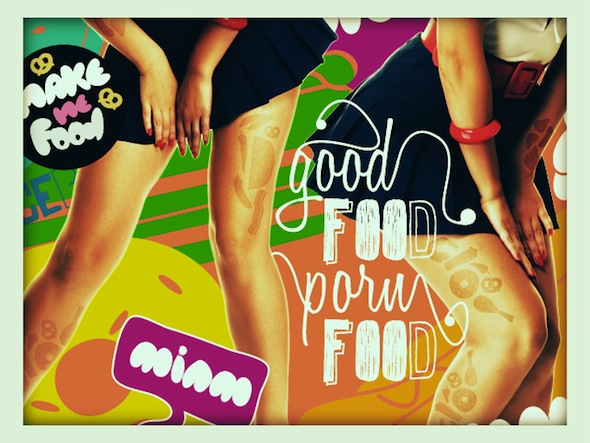Do you watch Food Porn?*
It’s been a few years now that the terms “food porn” or “foodography” have been used in culinary contexts. This new jargon was born in the United States but later expanded into Europe. First, let’s be clear: it’s not about pornography. Food Porn has nothing to do with the art of individuals exposing their bodies in front of a camera!
The concept originates from social changes that took place over the past generation. Cooking is above all a way of passing on a cultural heritage, often one that runs through the family. The redefinition of societal values during the 70s and 80s created a cultural deficit which deprived an entire generation of its own gastronomic heritage.
Logically, the Internet quickly filled this gap, becoming a new platform for sharing culinary know-how. Cooking blogs, typically maintained by passionate self-taught cuisine experts, have thus been multiplying, turning certain bloggers into mini web-celebrities. At a time when service providers are becoming cultural heroes, a manual activity like cooking is at the spotlight.
It’s all about sharing. We often associate cooking with love or affection. Several phases in the cooking process are important: there’s that of passing on the knowledge as mentioned above, then the creative part, and finally the actual action. But the moment which is mostly appreciated by those who sweat above their stoves is that of the feedback, of offering commentary. Cooking is a way of putting oneself at the forefront, of seeking recognition. TV shows like MasterChef or Come Dine With Me joined the online trend, bringing the commentary addiction to a new level, due to the competitive component, as well as the reinforced attention to food aesthetics.
Socials networks now allow any cook to share his or her activities with audiences larger than ever before. Such “Foodies” (or cooking amateurs) have thus also become photographers, cherishing their work in pictures in order to later share it with followers and friends; a habit which is now known as “food porn”. The term was originally used to describe quasi-erotic TV commercials which presented food (often vegetables) in a sensual way. Nowadays, the term “porn” can be found in various contexts, often describing a mix of images, meant to lure viewers towards a certain topic (architecture, automobile, etc.).
The more visually attractive the picture is, the more tempting its object becomes, and the more it will generate feedback and comments on social networks. In an era, known for its documentation of our almost daily existence, photography has become an image-based conversation tool.
In 1825, French gastronomist Jean-Anthelme Brillat-Savarin wrote: “Tell me what you are and I shall tell you what you eat” (which later evolved into the popular Anglo-Saxon idiom of “you are what you eat”). Things haven’t changed much since the time of Brillat-Savarin. Presenting in images what we eat is the new digital way of presenting oneself, of telling our story. The time when we eat makes up an important part of our daily lives, thus with three meals a day, food is a major part of our existence.
Mobile technology allows anyone to take a picture, share it, and comment on it. The wide spread of high-quality digital cameras plays an important role in this trend, well understood by brands like Nikon and Canon. Most of their models now have a “food mode” feature for optimising the quality of culinary photography.
Social platforms like Instagram or Pinterest are sometimes seen as the El Dorado of some (very) amateur food pornographists. Users’passion is often so great that it sparks mockery as illustrated in this “Read Write Web” article. Indeed, with Facebook pages such as this, it is hard to deny the article’s criticism… Sharing a picture of your pale ham and eggs from last Sunday is like thinking that your holiday photos resemble the Swimsuit edition of “Sports Illustrated”.
The most commonly-shared food pictures on social networks are desserts (18.3%) and vegetables (17.8%). High ranking of desserts can be explained by their aesthetic looks and colourfulness. Vegetables, on the other hand, have become a symbol of a healthy lifestyle, a trendy concept on its own.
Different motivations drive the picture sharing of home-made versus restaurant-made dishes. The former satisfies our need to be recognised for our skills, also known as the “IKEA effect”, wanting to share all our “I-did-it-myself” items. The latter, however, celebrates our individual’s capacity of being a “discoverer” of the best eateries, using photos as “proof” on social recommendation platforms. Many mobile applications are currently riding this trend, including Foodreporters in France and Foodspotting in the US. The fact that consumers prefer their peers’ advice over those of brands or institutions is creating an earthquake in the world of food guides. While many of those guides try to join the digital revolution, brands like Michelin or Gault Millaut are the first to pay the price for the rise of food porn.
*Originally written in French by Théo Saulnier for the Emakina.FR’s blog.
Our recent blog posts
See all blogs-
How is AI’s synthetic data enhancing User Experience Research? Technology

-
Web3.AI Rising : How new technology can add value to your business

-
How generative AI helped us create an e-commerce app – with personalised content – in just 2 weeks Technology

-
Can you build a foodie app in 3 days using Generative AI? (Spoiler alert: yes!)


